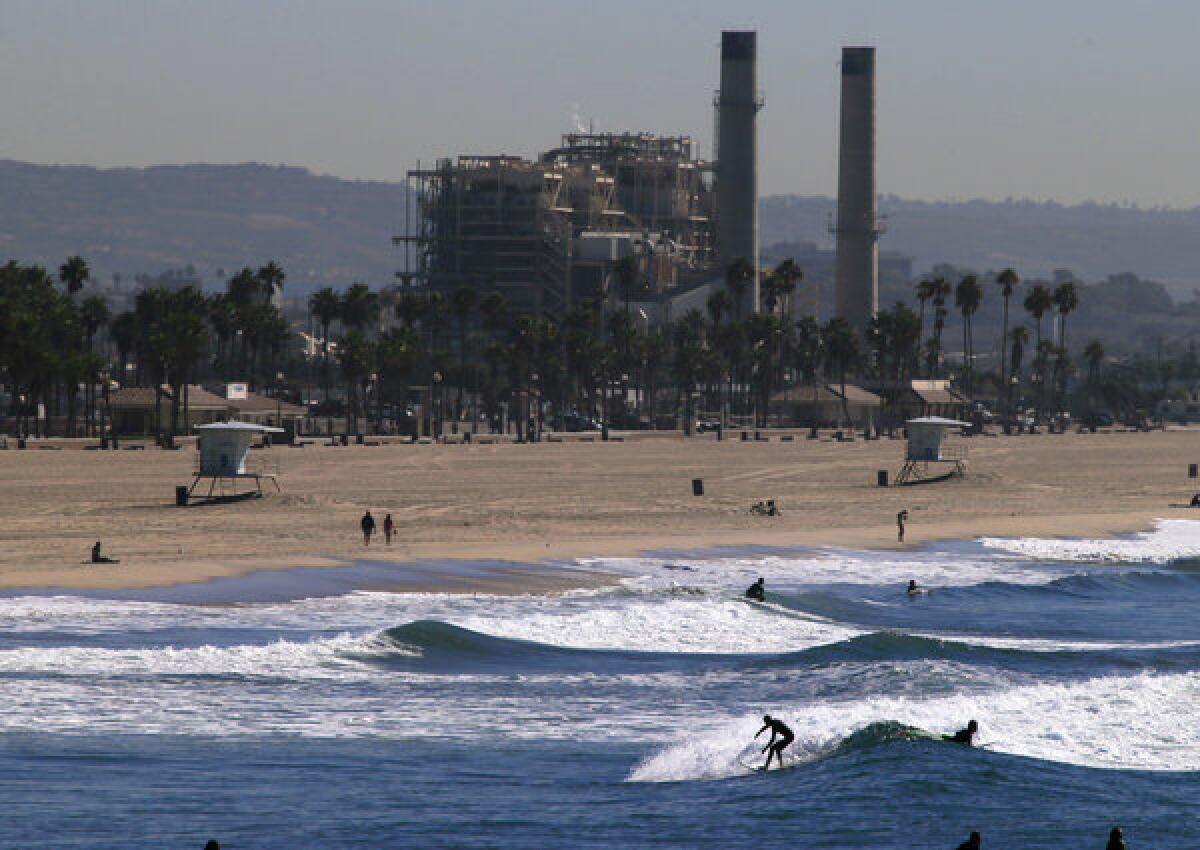Huntington Beach desalination plant appears headed for a key approval

- Share via
Poseidon Water’s long-delayed plans to build one of the West Coast’s biggest seawater desalination plants on the Huntington Beach coastline appear headed for a key approval.
A regional water board is proposing to grant Poseidon permits for a $1-billion desalting facility that would annually produce enough drinking water to supply 100,000 Orange County households.
The board will not vote on the project until March and Poseidon still needs approval from the California Coastal Commission.
But the water board’s tentative permit is a major boost for a project that has been mired in delays and controversy since it was first proposed two decades ago.
“We are one step closer to providing Orange County with a 100% drought proof, climate resilient new water supply project,” Poseidon communications director Jessica Jones said in an email.
In a tentative permit that Poseidon opponents quickly criticized, the Santa Ana Regional Water Quality Control Board would allow the company to use existing ocean pipes to draw seawater and discharge the brine left over from the desalting process.
“The regional board gave Poseidon everything they asked for,” said Sean Bothwell, executive director of California Coastkeeper Alliance, one of several environmental groups that have long fought the project.
“If the permit stays as it is now, we’ll certainly be appealing this,” he added.
As the first major coastal desalination plant to seek approval under new state ocean protection rules, the fate of Poseidon’s Huntington Beach facility could set the course for future projects, including a water district’s proposal to build a seawater desalter off the Los Angeles coast in El Segundo.
The proposed ocean intake off of Huntington Beach has been a major point of contention. It would, with some modification, continue a form of seawater withdrawal that the state ordered coastal power plants to phase out because it killed minute marine life.
Poseidon plans to build the desalter next to the AES Huntington Beach Generating Station, and after the power plant stops using seawater for cooling, connect the new desalter to the old AES intake pipe that reaches roughly a quarter-mile into the Pacific Ocean and is big enough for a tractor-trailer to drive through.
The state Coastal Commission staff has pushed Poseidon to abandon the open ocean intake, which sucks up plankton, fish larvae and other organisms that are a vital part of the sea’s food chain.
Instead, the commission staff has urged the company to construct an offshore subsurface intake called an infiltration gallery — a grid of perforated collection pipes beneath the ocean floor that draws seawater without pulling in marine organisms.
But it is the regional water board, not the Coastal Commission, that issues permits for Poseidon’s ocean intake and discharge. Citing a provision in the new ocean rules, board staff concluded that subsurface intakes wouldn’t work for such a large-volume desalination operation.
Poseidon has agreed to install fine-mesh screens on the intake to reduce marine mortality. It will also attach diffusing equipment to the end of the outfall pipe to prevent the dense brine effluent — twice as salty as seawater — from falling to the ocean floor in a deadly mass.
“The tentative order is scientifically sound … and correctly finds the proposed facility complies with the California Ocean Plan by using the best available site, design, technology and mitigation measures feasible,” Jones said.
Ocean advocates argued that the water board proposal ignores the core of the new state desalination safeguards.
“They’re not requiring Poseidon to meet any of the top tier standards in the desalination [rules], which are the critical standards,” said Susan Jordan, executive director of the California Coastal Protection Network.
Despite seawater desalination’s appeal as a drought-proof water supply in a semi-arid state, California has been slow to embrace the coastal plants, which are energy intensive, produce expensive water and exact a toll on the ocean environment.
Poseidon has spent more than $1.6 million on lobbying and political campaign contributions during the past two decades to overcome those reservations. In 2017, it hired former California Sen. Barbara Boxer to lobby the coastal commission.
The company, which is owned by an international infrastructure firm, built California’s first big seawater desalter on the Carlsbad coast in San Diego County.
That facility was recently sold to Aberdeen Standard Investments for an undisclosed sum. Poseidon will continue to operate the plant, which has a long-term contract to supply the San Diego County Water Authority.
Poseidon has a nonbinding agreement with the Orange County Water District to purchase the Huntington Beach supplies, but no final contract.
A recent study by another Orange County agency concluded that other, less expensive water sources could meet the area’s future demand.







